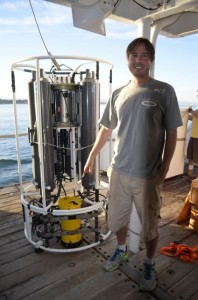After a full day of sediment coring and me figuring out how to communicate with my instrumentation, we finally made it to the location offshore of Point Sur to observe the California Undercurrent. The undercurrent is a swift poleward flow, which is counter to the prevailing southward flow of the California Current, and carries warm, salty, and nutrient rich waters. The undercurrent doesn’t have a surface expression so using ships such as the R/V Pt. Sur is essential at observing it. The undercurrent resides at the shelf break between 1000-3500 m water column depth with maximum currents typically between 150-300 m depth. The undercurrent actually travels the whole western coastline with signatures of the current observed as far north as Alaska. We chose this particular transect based on previous studies by Curt Collins at the Naval Postgraduate School and proximity to Moss Landing.
To accompany the shipboard ADCP (instrument to measure upper ocean currents) we did CTD casts to measure the temperature, salinity, and oxygen of the water column at each end of the ~100 km transect and at the mean position of the core of the current in ~2500 m water column depth at the shelf break. At the beginning of the transect we started cruising from deep water offshore towards land perpendicular to the coast. When we arrived at the projected core location of the current we certainly didn’t see what we expected to see. We actually saw southward flow at the site according to the Shipboard ADCP. As we continued down the transect line we realized that we were in the midst of a large counter clockwise current system we call an eddy. Eddies are exciting features and are hard to predict when they will occur. It turns out the eddy was transporting a large plume of high chlorophyll water off shore from the headland of Monterey Bay. This frontal zone of high chlorophyll also prompted the use of the MOCNESS by Ryan to check out this front to the north of the transect line (see his blog post).
We ended the transect of the undercurrent near sunset with absolutely stunning weather. The winds were light and the seas were calm. A group of dolphins surfed the bow wake at the front of the boat and whales breached off in the distance as a group of us tried to spot the infamous green flash as the sun set over a cloudless sky.
Stu shows off his lowered ADCP (the yellow instrument), which he uses to measure ocean currents.
Collecting water from the CTD-mounted Niskin bottles.
photo credits: Top- Amanda Netburn, Bottom- Amy Wagner


